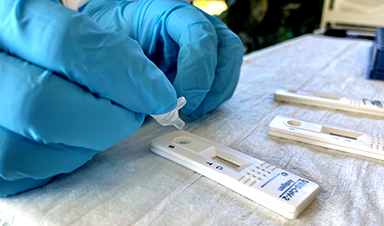The World Health Organization (WHO) and Centers for Disease Control and Prevention (CDC) are tracking and studying a highly mutated new variant of the virus that causes COVID-19. Officially titled BA.2.86 and nicknamed Pirola on social media, the WHO has designated it as a “variant under monitoring.” This status applies to variants that have an unusually large number of mutations that call for monitoring as they spread.
According to Fred Hutchinson Cancer Center evolutionary biologist Jesse Bloom, BA.2.86 has more than 30 amino acid changes in its spike protein, compared with its next closest ancestor (Omicron’s BA.2 subvariant).
“We have not seen a new variant [in humans] with this many new spike mutations happening all at once since the emergence of the original Omicron,” Bloom told NBC News. “Based on the sequence, I think we can be very confident this [variant] is going to be relatively good at evading the antibodies that most people have from prior infections and vaccinations. What we still don’t know is, is this variant good enough at transmitting that it will really be able to spread widely around the world?”
So far, only six sequences BA.2.86 have been reported in the United States, United Kingdom, Israel, and Denmark, but epidemiologists are concerned that it is circulating in more places since monitoring COVID-19 variants has dropped.
“It is unusual for corona to change so significantly and develop 30 new mutations. The last time we saw such a big change was when Omicron appeared,” Morten Rasmussen, a senior researcher at the Statens Serum Institut (SSI) in Denmark, said in a statement.
SSI scientists stressed that it is currently too early to say if this new variant is more contagious or severe and that they are in the process testing it against human antibodies.
The CDC will keep monitoring BA.2.86, but did not say it is not currently a cause for alarm. According to the CDC’s variant tracker, the XBB descendant EG.5 (nicknamed Eris) is causing roughly 20 percent of all new COVID-19 cases in the US and is the dominant variant. The next most common variant is FL.1.5.1, causing about 13 percent new cases.
[Related: Your guide to COVID testing for the unforeseeable future.]
“I think what we are seeing is our detection mechanisms that we’ve put in place are working, right?” CDC Director Mandy Cohen told CNN. “We are more prepared than ever to detect and respond to changes in the COVID-19 virus.”
As the fall and winter virus season approaches, COVID-19 cases are expected to continue to climb around the US. The Food and Drug Administration (FDA) is expected to authorize updated booster shots soon, with signoff from the CDC expected by mid-September. The new boosters won’t include the specific EG.5 subvariant or BA.2.86, but will target the XBB strains.
News
COVID-19 still claims more than 100,000 US lives each year
Centers for Disease Control and Prevention researchers report national estimates of 43.6 million COVID-19-associated illnesses and 101,300 deaths in the US during October 2022 to September 2023, plus 33.0 million illnesses and 100,800 deaths [...]
Nanomedicine in 2026: Experts Predict the Year Ahead
Progress in nanomedicine is almost as fast as the science is small. Over the last year, we've seen an abundance of headlines covering medical R&D at the nanoscale: polymer-coated nanoparticles targeting ovarian cancer, Albumin recruiting nanoparticles for [...]
Lipid nanoparticles could unlock access for millions of autoimmune patients
Capstan Therapeutics scientists demonstrate that lipid nanoparticles can engineer CAR T cells within the body without laboratory cell manufacturing and ex vivo expansion. The method using targeted lipid nanoparticles (tLNPs) is designed to deliver [...]
The Brain’s Strange Way of Computing Could Explain Consciousness
Consciousness may emerge not from code, but from the way living brains physically compute. Discussions about consciousness often stall between two deeply rooted viewpoints. One is computational functionalism, which holds that cognition can be [...]
First breathing ‘lung-on-chip’ developed using genetically identical cells
Researchers at the Francis Crick Institute and AlveoliX have developed the first human lung-on-chip model using stem cells taken from only one person. These chips simulate breathing motions and lung disease in an individual, [...]
Cell Membranes May Act Like Tiny Power Generators
Living cells may generate electricity through the natural motion of their membranes. These fast electrical signals could play a role in how cells communicate and sense their surroundings. Scientists have proposed a new theoretical [...]
This Viral RNA Structure Could Lead to a Universal Antiviral Drug
Researchers identify a shared RNA-protein interaction that could lead to broad-spectrum antiviral treatments for enteroviruses. A new study from the University of Maryland, Baltimore County (UMBC), published in Nature Communications, explains how enteroviruses begin reproducing [...]
New study suggests a way to rejuvenate the immune system
Stimulating the liver to produce some of the signals of the thymus can reverse age-related declines in T-cell populations and enhance response to vaccination. As people age, their immune system function declines. T cell [...]
Nerve Damage Can Disrupt Immunity Across the Entire Body
A single nerve injury can quietly reshape the immune system across the entire body. Preclinical research from McGill University suggests that nerve injuries may lead to long-lasting changes in the immune system, and these [...]
Fake Science Is Growing Faster Than Legitimate Research, New Study Warns
New research reveals organized networks linking paper mills, intermediaries, and compromised academic journals Organized scientific fraud is becoming increasingly common, ranging from fabricated research to the buying and selling of authorship and citations, according [...]
Scientists Unlock a New Way to Hear the Brain’s Hidden Language
Scientists can finally hear the brain’s quietest messages—unlocking the hidden code behind how neurons think, decide, and remember. Scientists have created a new protein that can capture the incoming chemical signals received by brain [...]
Does being infected or vaccinated first influence COVID-19 immunity?
A new study analyzing the immune response to COVID-19 in a Catalan cohort of health workers sheds light on an important question: does it matter whether a person was first infected or first vaccinated? [...]
We May Never Know if AI Is Conscious, Says Cambridge Philosopher
As claims about conscious AI grow louder, a Cambridge philosopher argues that we lack the evidence to know whether machines can truly be conscious, let alone morally significant. A philosopher at the University of [...]
AI Helped Scientists Stop a Virus With One Tiny Change
Using AI, researchers identified one tiny molecular interaction that viruses need to infect cells. Disrupting it stopped the virus before infection could begin. Washington State University scientists have uncovered a method to interfere with a key [...]
Deadly Hospital Fungus May Finally Have a Weakness
A deadly, drug-resistant hospital fungus may finally have a weakness—and scientists think they’ve found it. Researchers have identified a genetic process that could open the door to new treatments for a dangerous fungal infection [...]
Fever-Proof Bird Flu Variant Could Fuel the Next Pandemic
Bird flu viruses present a significant risk to humans because they can continue replicating at temperatures higher than a typical fever. Fever is one of the body’s main tools for slowing or stopping viral [...]





















